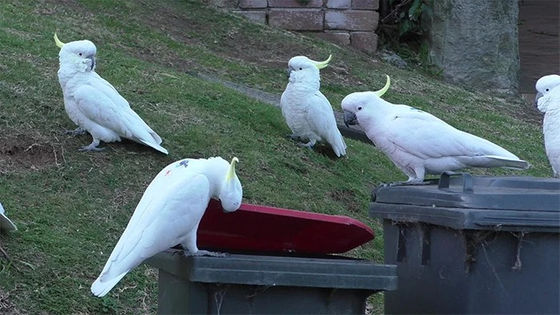Reports that parrots are rapidly learning the act of 'opening the trash can lid'

Innovation and geographic spread of a complex foraging culture in an urban parrot | Science
https://science.sciencemag.org/content/373/6553/456
Clever cockatoos in southern Sydney have learned to open kerb-side bins — and it has global significance
https://theconversation.com/clever-cockatoos-in-southern-sydney-have-learned-to-open-kerb-side-bins-and-it-has-global-significance-164794
Cockatoos in Australia Are Teaching Each Other How to Loot Trash Cans
https://www.sciencealert.com/clever-cockatoos-have-learnt-and-spread-a-culture-of-trash-bin-looting
Kibatan is a large parrot with extremely high intelligence and abundant curiosity, characterized by an eye-catching yellow crest. While Kibatan is loved as a pet because of its intelligence, it is treated as a pest because of the overgrowth of wild populations in Australia.
In recent years, it has been reported one after another in Australia that this Kibatan 'opened the lid of the trash can and began to fish the contents.' The actual video is below.
Cockatoo raiding bin --YouTube
In the video below, the weight placed on the lid is also dexterously removed to open the lid.
Cockatoo's getting into our bins --YouTube
Barbara Crump and colleagues at the Max Planck Institute in Germany noted that reports of 'Kibatan opening the lid of a trash can' date back to 2014 near Sydney, Australia, and the behavior in question among Kibatan. I investigated how it spread.
As a result of continuous interviews with 478 residents living in the suburbs of Sydney, 338 out of 1396 reports reported that they had seen Kibatan opening the trash can lid. Interviews prior to 2018 found that reports of 'I've seen' were limited to three locations on the outskirts of Sydney, which were quite far from each other, but in 2019, 'I've seen them.' The number of areas reporting 'yes' has increased rapidly to 41.
Analysis of these reports revealed that similar reports were gradually made in areas adjacent to the area where Kibatan was reported to open the lid of the trash box, and more than 90% of the reports of Kibatan opening the lid were ' Since it included the content that 'I was observing how other individuals opened the lid,' it is thought that 'Kibatan is learning the act of opening the lid of the trash can from the same species.' About 10% of the herds learned this act of opening the lid, and it was also found that adult males are most likely to understand the act of opening the lid.

In addition, in the paper published this time, 'differences in how to open the lid' are also the subject of research. Even among the Kibatan who learned to open the lid of the trash can, there were differences in 'how to open the lid' and 'acts after opening the lid' depending on the region. In the video below, we capture the style of 'opening the lid with just the mouth' and the style of 'opening with the legs and mouth' respectively.
Sydney's Cockatoos Have Found Multiple Ways of Opening Bins --YouTube
As for the act after opening the lid, the style of 'walking around on the right side of the trash can opening' was the mainstream in northern Sydney, while the style of 'dancing or jumping violently' was the mainstream in central Sydney. Regarding these differences in style, it is believed that the style of Kibatan, which introduced the culture of 'opening the lid of the trash can' to each region, is followed.
Regarding the above report of 'opening the trash can lid' in Kibatan, Australia, research team John Martin explained that 'it is important to show that animals showing social learning can be observed in daily life.' .. He said that he reaffirmed the idea that 'non-human species may also be culturally diverse,' which was said to have appeared in the scientific community in the 1950s.
Related Posts:







